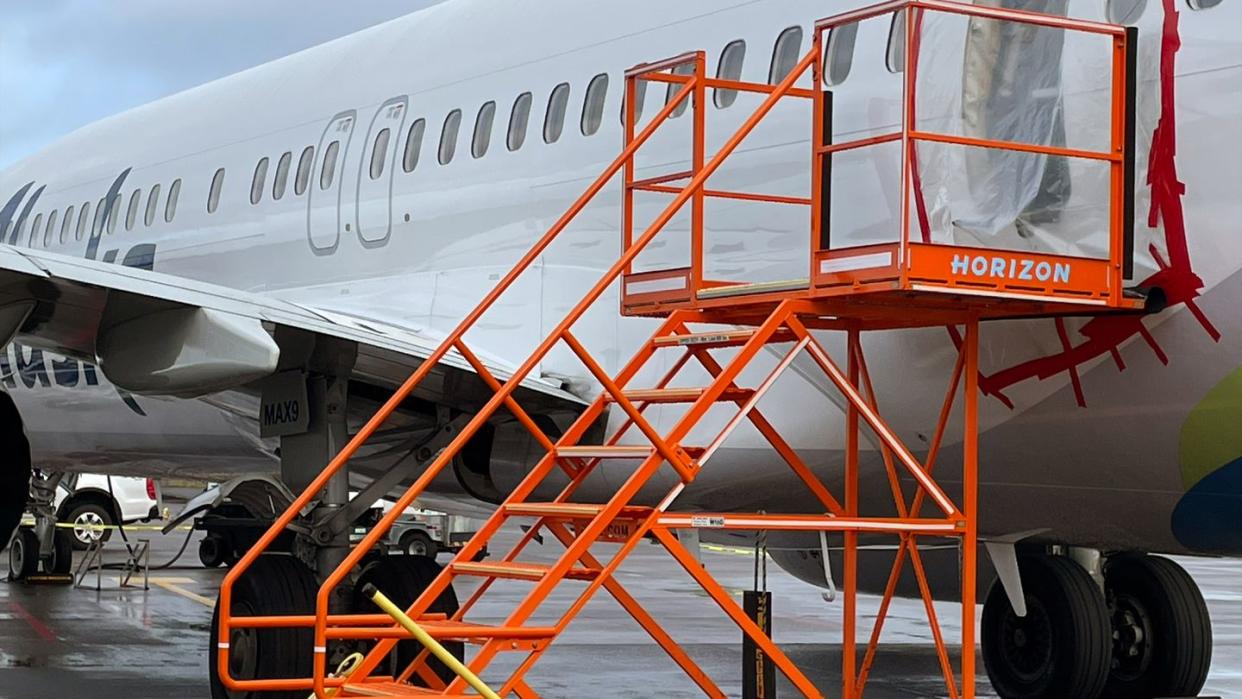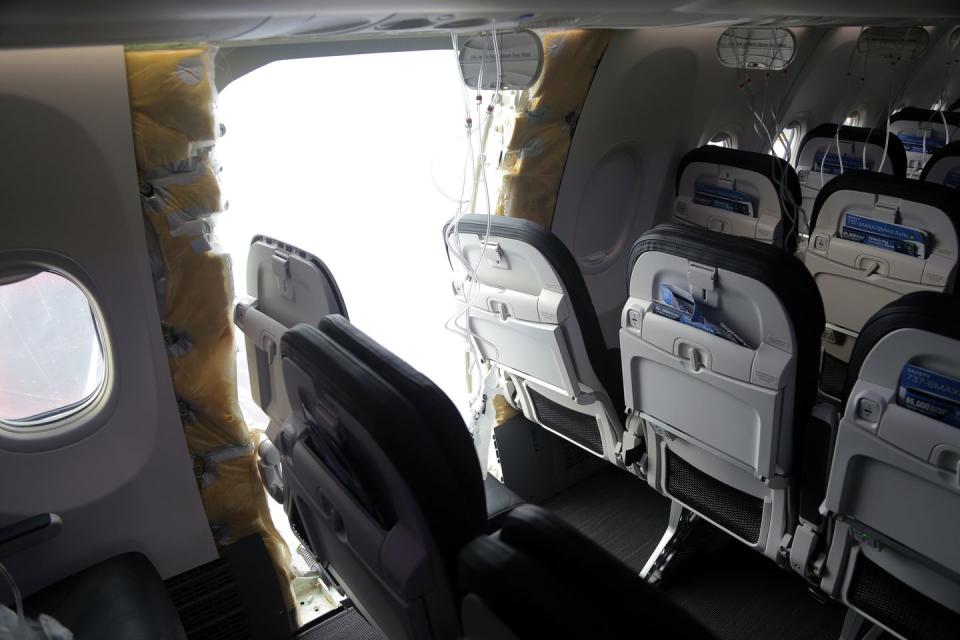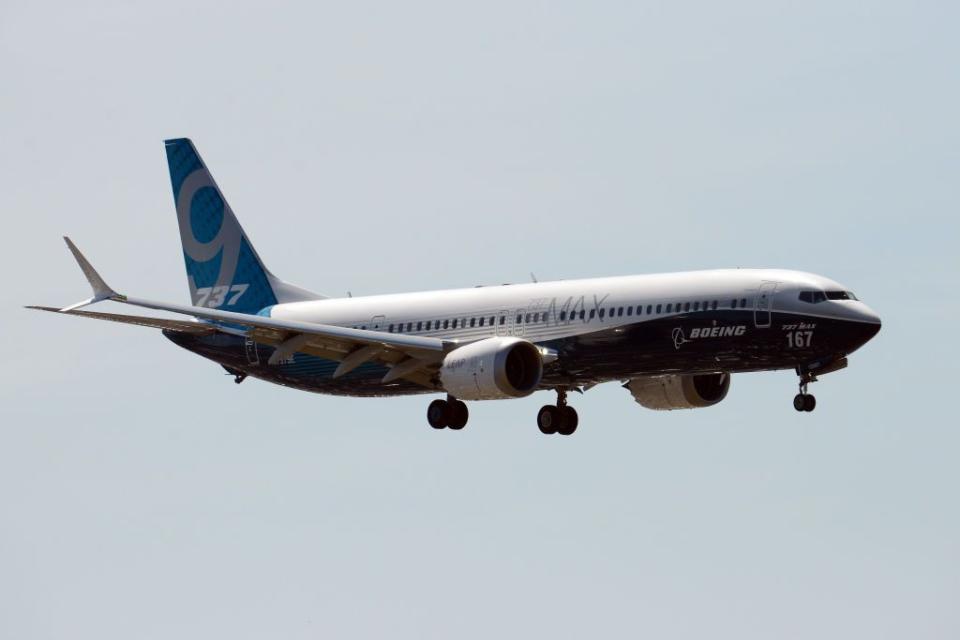An Airplane’s Door Plug Popped off Mid-Flight—And Landed In Someone’s Backyard

A redundant safety feature perversely became a source of danger last Saturday, when the plug filling an unused mid-cabin emergency exit door popped off of the left side of Alaska Airline Flight 1282 just six minutes after it took off from Portland International Airport, violently depressurizing the aircraft at 16,000 feet.
Fortunately, no one was occupying the two seats next to the plug.

Amidst the din of whooshing air, the Boeing 737MAX-9’s flight crew was able to loop the aircraft around Portland and make an emergency landing 20 minutes later with all 171 passengers and six flight crew left shaken, but without serious injuries. The air pressure change did cause minor injuries, and sucked out personal items, a pilot’s headset, and bits of the plane’s interior (including headrests).
Investigators trying to determine the exact cause of this unusual mishap likely feared that they would never have a chance to inspect the delinquent 26x48” door plug. But fortunately, the 63-pound plug was found tangled admits some trees in the backyard of a school teacher named Bob in Cedar Hills, Oregon. Its presence was reported to the National transportation Safety Board (NTSB) on Sunday evening.
Possibly even more remarkably (though of less consequence), two cell phones that were sucked out of planes were also located—one of which was still functioning in ‘airplane mode.’
Found an iPhone on the side of the road... Still in airplane mode with half a battery and open to a baggage claim for #AlaskaAirlines ASA1282 Survived a 16,000 foot drop perfectly in tact!
When I called it in, Zoe at @NTSB said it was the SECOND phone to be found. No door yet😅 pic.twitter.com/CObMikpuFd— Seanathan Bates (@SeanSafyre) January 7, 2024
Unfortunately, the jet’s Cockpit Voice Recorder recording of the incident was not saved due to an oversight and its limited 2-hour storage. This led NTSB chair Jennifer Homendy to request that all jetliners be refitted with 25-hour storage recorders.
The plug and the aircraft’s surrounding doorframe are literally going under the microscope in a lab in Washington DC to determine what factors were at fault.
NTSB has recovered the door plug from Alaska Airlines Flight 1282 Boeing 737-9 MAX. NTSB investigators are currently examining the door plug and will send it to the NTSB Materials Laboratory in Washington, DC for further examination. pic.twitter.com/fqeemNeBPW
— NTSB Newsroom (@NTSB_Newsroom) January 8, 2024
This particular 737 MAX-9 jet (serial number 67501 and designation N704AL) was virtually factory fresh, having been delivered just over 2 months earlier on October 31, 2022. Thus, suspicions have fallen on the plug’s manufacturer and assembler, Spirit Aerosystems and Boeing, respectively. It’s possible, however, that the plug had been removed and then re-bolted by Alaska Airlines maintainers.
On Sunday, the FAA issued an Emergency Air Worthiness Directive to ground the 171 737 MAX-9 aircraft fitted with window plugs until they can be inspected and corrective actions are implemented to avert risk of future accidents. The specific measures were detailed by Boeing in a multi-operator message this Monday morning.
One angle of interest is that N704AL had three prior incidents of auto-pressurization failure warnings on Dec. 7, Jan. 3, and Jan. 4 (the middle incident occurring midflight). These warnings were not reproduced when the warning systems were reset according to standard pressure, but hypothetically could be linked to the apparently insecure plug.
Perhaps more interestingly, however, aviation publication The Air Current reported on Monday afternoon that United Airlines had found loose bolts and other parts on the door plugs of at least five of its 737 MAX 9 jets. Edward Russell, editor of Airline Weekly, subsequently shared an image of several of the loose bolts.
Following @jonostrower's scoop on United finding 737-9s with loose door plug screws, a source sent this image of one of the door plug's lower hinge bracket with a note that 2 screws are not screwed all the way in. https://t.co/sz1d997PdL pic.twitter.com/d6hgHAEb2u
— Edward Russell (@ByERussell) January 8, 2024
The incident marks a new blow to Boeing’s 737 MAX jet, the fourth-generation model of the classic twin-engine short-haul airliner which began production over a half-century ago in 1966. MAX’s reputation was severely tarnished by two deadly accidents in 2018 and 2019—linked to an over-aggressive new flight control system inadequately explained to pilots—causing the rival Airbus A320neo to pull ahead in sales.
More recently, and more pertinent to the Alaska Airlines incident, deliveries of new 737 MAXs have been delayed by drilling errors that proved extremely time-consuming to correct. Such issues, and those surrounding its troubled KC-46A Pegasus refueling tanker, have led critics to allege that cultural problems at Boeing are at fault.
What’s the deal with 737 window plugs?
The stretched 737 MAX-9 variant is the largest of three passenger-carrying 737 MAX models in service, with a maximum seating expanded to 221 passengers (though at some reduction to maximum range). An even larger 737 MAX-10 configuration (max 230 seats) and a smaller MAX 7 model (up to 172 seats) are both slated to enter service in 2024.

Regulations require aircraft carrying 190 or more people to feature additional midcabin emergency exit doors (which fold down vertically rather than being hinged sideways) on each side of the fuselage. After all, nobody wants to be at the back of a huge line trying to exit from an aircraft that may be on fire or sinking in water.
But some airlines don’t plan to fill more than 189 of their seats on their MAX-9s—saving weight and affording more leg room to passengers—and thus aren’t required to have the extra doors. In baseline configuration, such aircraft retain a deactivated, windowless version of the bulky door (the standard configuration) and are limited to only carrying 175 persons.
However, an alternative option is to swap in a slimmer, handle-less door plug with a full-sized window that allows a full-sized row of passenger seating to be installed next to it. This option, unique to the MAX-9 subvariant, pumps max seating back up to 189—though it is much more costly to reconfigure than a deactivated door.
The plugs are meant to be openable when undergoing maintenance. Thus, there are two hinges and lift-assist springs on the plug’s bottom edge and a roller track on the frame’s top edge to pop the door out and fold it downwards.
But the plugs are never meant to be opened during flight operations. Thus, they’re secured with four bolts: two pinned locking bolts on the upper frame constraining the roller guides, and two arrestor bolts pinning its hinges vertically to the bottom frame. Twelve stop-fittings and pads across both sides of the plug’s frame help redistribute pressure across the entire frame.
The video below by Chris Brady—a retired 737 pilot, 737 fleet manager and aviation safety expert—shares details on the various assemblies described above.
Photos from within and outside the aircraft after the incident show the plug relatively cleanly detached, without having torn the fuselage itself or even warping its bottom-mounted hinges.
The discovery of loose parts on multiple aircraft by other airlines increasingly seems to suggest a systemic quality control problem that Boeing and Spirit Aerosystems will have to untangle.
Figuring out how and why the plug’s various bolts and fittings ended up making the object so susceptible to external pressures pulling it outward poses uncomfortable questions for companies. But those are not nearly as uncomfortable as questions raised after a fatal accident. Hopefully, insights gained and reforms made based on the present investigation will help prevent one from happening.
You Might Also Like

